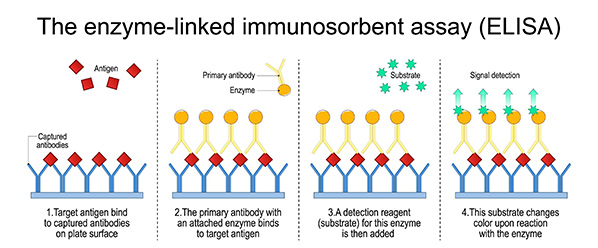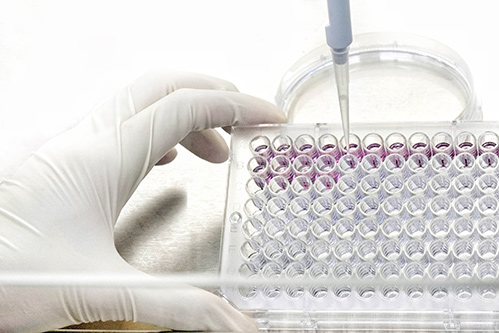Enzyme-Linked Immunosorbent Assay (ELISA)
In the fields of life science research, clinical diagnostics, and drug development, fluorescent enzyme-linked immunosorbent assay (Fluor-ELISA) has become a key method in bioanalysis due to its high sensitivity, wide applicability, and multiplex detection capabilities. BOC Sciences, with its extensive experience in the development of fluorescent dyes and probes, focuses on providing high-performance fluorescent enzyme substrates and customized fluorescent probe design services for Fluor-ELISA, helping researchers and companies achieve higher resolution and lower detection limits in quantitative assays. We offer comprehensive support, from substrate screening to fluorescence system optimization, and from structural modifications to large-scale synthesis, ensuring that each probe and substrate possesses excellent stability, specificity, and fluorescence response.
Enzyme-Linked Immunosorbent Assay

The Enzyme-Linked Immunosorbent Assay (ELISA) is a method that uses the antigen-antibody specific binding reaction, combined with enzyme labeling and color development systems, to detect and quantify specific proteins such as antibodies, antigens, hormones, or cytokines. It is a widely used and important method in modern immunodiagnostics, applied in fields such as medical diagnostics, biological research, and food safety testing. Fluorescent ELISA (Fluor-ELISA) is an immune analysis method based on the antigen-antibody specific binding and fluorescent signal quantification. Its basic principle involves labeling antibodies with enzymes, binding them to target molecules, and then adding a fluorescent enzyme substrate. The enzyme catalyzes the substrate to produce a fluorescent signal, and the fluorescence intensity is used for quantitative analysis. Compared to traditional colorimetric ELISA, Fluor-ELISA offers higher sensitivity, a broader dynamic detection range, and the ability for multiplex detection, making it suitable for complex sample analysis. Fluor-ELISA is widely used in disease biomarker detection, viral antibody screening, vaccine research, pharmacokinetics, toxicology analysis, and molecular interaction studies. Its high speed, high throughput, and potential for automation make it a key method in clinical diagnostics, biopharmaceuticals, and academic research.
Technical Advantages of BOC Sciences in Fluorescent ELISA Solutions
Comprehensive Fluorescent Substrate Library
We offer a variety of high-performance fluorescent substrates for common enzymes such as HRP, ALP, and β-Gal. These substrates feature high quantum yields and excellent water solubility, making them suitable for different platforms and sample types.Probe Structure Customization and Large-Scale Synthesis
We support the optimization of substrate structures, functional group modifications, and industrial-scale synthesis to ensure batch stability and scalability.Fluorescent Signal System Coupling Design
We provide efficient coupling services for fluorophores with antibodies or affinity tags, enabling the construction of stable and non-interfering signal amplification systems.Professional Technical Support and Solution Development
Our team of scientists with expertise in analytical chemistry, organic synthesis, and immunoassay is ready to provide customized strategic advice and reagent screening services for various research objectives.
One-Stop Fluorescent Enzyme Substrate Solutions for Fluorescent ELISA
In the Fluor-ELISA system, selecting the appropriate fluorescent enzyme substrate is crucial for ensuring sensitivity, specificity, and stability. BOC Sciences has developed and optimized a series of high-performance fluorescent enzyme substrates for the three most commonly used enzyme systems in ELISA experiments—HRP (Horseradish Peroxidase), ALP (Alkaline Phosphatase), and β-Gal (β-Galactosidase). We offer a wide range of substrates with high fluorescence quantum yield, strong water solubility, and low background, compatible with conventional and high-throughput analysis equipment such as microplate readers, fluorescence imaging systems, and flow cytometry platforms. Additionally, we support customized substrate structure, fluorophore type, and detection wavelength ranges to meet diverse ELISA research goals. The following are representative fluorescent substrate products for the three major enzyme systems:
HRP Fluorescent Substrates
- Amplex® Red
- Tyramide-Alexa Fluor® 488
- sulfo-Cyanine5 tyramide
- Hydroxyphenylacetic acid (HPAA)
- 10-Acetyl-3,7-dihydroxyphenoxazine (ADHP)
ALP Fluorescent Substrates
- 4-Methylumbelliferyl phosphate (4-MUP)
- DiFMUP
- AttoPhos®
- ELF®-97 phosphate
- Fluorescein diphosphate (FDP)
β-Gal Fluorescent Substrates
- Fluorescein di-β-D-galactopyranoside (FDG)
- Resorufin-β-D-galactopyranoside
- C12FDG
- 5-Dodecanoylaminofluorescein-di-β-D-galactopyranoside
- Magenta-Gal
Customized Fluorescent Probe Design Services for Diverse ELISA Needs
In response to the increasingly diversified research demands in Fluor-ELISA experiments, BOC Sciences offers a full-service customized fluorescent probe design, covering key stages such as substrate structure modification, fluorophore labeling, affinity tag design, and multiplex detection system development. We integrate advantages in organic synthesis, fluorescence labeling, bioconjugation, and analytical method development to support clients in flexibly selecting enzyme types, probe structures, and fluorescent properties according to their research goals, creating high-sensitivity, low-background, and multiplexable probe systems. Combining structural optimization and large-scale synthesis capabilities, we can quickly translate concept designs into pilot-scale production, improving the overall performance of the ELISA platform in complex sample analysis, multi-parameter detection, and high-throughput screening.
Enzyme Substrate Structure Optimization and Large-Scale Synthesis
- Functional group modification based on customer-specified enzymes or substrate structures.
- Enhanced water solubility, improved fluorescence intensity, or selective improvements.
- Process scale-up, supporting mg to kg-level batch delivery.
Fluorophore-Antibody Conjugation Modifications
- Providing fluorophores such as FITC, Cy3, Cy5, Alexa Fluor.
- Using coupling strategies like NHS ester, Maleimide, and Click chemistry.
- Ensuring antibody activity and stable fluorescence output.
Affinity Tag Design and Labeling Services
- Design and labeling of affinity structures such as Biotin, Streptavidin, and His-tag.
- Supporting biotin-antibody or fluorescent-streptavidin affinity systems.
- Enabling detachable and modular signal transduction.
Multiplex Fluorescent ELISA System Development Recommendations
- Design of non-overlapping fluorescence combinations.
- Reducing signal interference and enabling coexistence of multiple markers.
- Providing multi-color system optimization reagents and custom buffer solutions.
Quality Control Services for Fluorescent Enzyme Substrates and Probes
When providing solutions for fluorescent enzyme substrates and probes, BOC Sciences always places quality control at the core. To ensure the efficiency and reliability of products in various research and applications, we adopt a strict quality control process that covers every stage, from raw material procurement and production to final product shipment. We are committed to offering high-quality reagents that meet international quality standards, ensuring their performance in terms of sensitivity, stability, and batch-to-batch consistency.
- Raw Material and Ingredient Quality Testing: Using analytical methods such as HPLC, MS, and UV-Vis Spectrophotometry, we assess the purity and stability of raw materials to ensure product quality from the source.
- Product Stability Testing: Through accelerated aging tests, we ensure the fluorescence signal stability, reaction rate, and shelf-life of products during use, thus enhancing experimental reliability.
- Batch-to-Batch Consistency Verification: We regularly conduct batch-to-batch consistency tests to ensure uniformity in fluorescence intensity, reaction sensitivity, and background noise across different batches.
- Functional Testing: All products undergo functional testing to simulate real experimental conditions, evaluating the fluorescence signal intensity, reaction rate, and other performance metrics.
- Fluorescence Property Evaluation: We accurately measure the fluorescence intensity, quantum yield, and photostability of fluorescent substrates and probes under different excitation and emission wavelengths to ensure excellent fluorescence characteristics under standard experimental conditions.
- Reaction Time and Kinetic Analysis: By testing the reaction time and kinetics of fluorescent substrates, we assess the catalytic rate under various concentrations and reaction conditions, ensuring the products are suitable for efficient experimental setups.
Advanced Analytical Platform
- High-Performance Liquid Chromatography (HPLC)
- Mass Spectrometry (MS)
- UV-Vis Spectrophotometer
- Fluorescence Spectrometer
- Confocal Laser Scanning Microscopy
- Fluorescence Polarization
- Automated ELISA Analyzer
- Colorimeter
- Fluorescence Microplate Reader
- Fourier-Transform Infrared Spectrometer (FTIR)
- Gas Chromatography (GC)
- Particle Size Analyzer
Fluorescent ELISA Research Applications We Support
BOC Sciences is dedicated to providing comprehensive technical support for various fluorescent ELISA research applications, especially in protein quantification, antibody screening, pathogen detection, and biomarker analysis. The high-quality fluorescent enzyme substrates and probes we offer help clients achieve precise and efficient detection in fields such as biomedical research, drug development, and clinical diagnostics. Whether it's high-throughput screening or complex sample analysis, our fluorescent reagent solutions can optimize experimental conditions, enhance sensitivity, and ensure reliability and reproducibility. Below is a detailed introduction to our core research directions:

Protein Quantification and Detection
Fluorescent ELISA is an ideal tool for protein quantification, widely used for precise measurement of protein concentration in various biological samples. With the fluorescent enzyme substrates and probes provided by BOC Sciences, high sensitivity and a wide dynamic range can be achieved even in low-concentration and complex backgrounds, providing strong support for protein expression research and drug screening.
Antibody Screening and Affinity Evaluation
Antibody screening is a key step in drug development. Fluorescent ELISA enables efficient screening of antibodies with the best affinity and specificity. BOC Sciences' customized fluorescent probes and substrates assist researchers in quickly confirming the activity and concentration of target antibodies during the early stages of antibody production, improving the efficiency of antibody development.
Pathogen Detection and Immunodiagnosis
Fluorescent ELISA technology is widely used in pathogen microorganism detection. Our fluorescent reagents can accurately identify specific pathogen antigens or antibodies, suitable for the diagnosis of infectious diseases caused by viruses, bacteria, and other pathogens. Through customized fluorescent probe and substrate solutions, the sensitivity and specificity of detection can be enhanced, facilitating rapid clinical diagnosis.
Biomarker Detection and Screening
Biomarker detection is crucial for early disease diagnosis and drug development. With the fluorescent ELISA solutions provided by BOC Sciences, researchers can efficiently screen and quantify biomarkers. Whether it's tumor biomarkers, cardiovascular disease markers, or other specific markers, our customized reagent solutions meet the high sensitivity requirements.
FAQs About Fluorescent ELISA
What is enzyme-linked immunosorbent assay?
Enzyme-linked immunosorbent assay (ELISA) is a biochemical technique used to detect and quantify soluble substances such as proteins, peptides, antibodies, and hormones. It involves an enzyme-conjugated antibody that binds to the target molecule, resulting in a detectable signal. ELISA typically uses a solid phase (e.g., microplates) where the sample is incubated, and the interaction between the target antigen and specific antibody is measured through colorimetric, fluorescent, or chemiluminescent signals. ELISA is widely used in diagnostics, research, and drug development due to its high sensitivity, specificity, and ease of use.
How does enzyme linked immunosorbent assay work?
ELISA works by utilizing specific antibodies to capture and detect an antigen. The assay is typically carried out in a microplate, where an antigen or antibody is immobilized on a solid surface. A sample is added, allowing the antigen (or antibody) in the sample to bind to the immobilized antibody (or antigen). After washing away unbound substances, a secondary enzyme-conjugated antibody is added. The enzyme reacts with a substrate, producing a detectable signal (color, fluorescence, or light), which is proportional to the concentration of the antigen in the sample. The signal intensity is measured, and results are quantified.
Can elisa be fluorescent?
Yes, ELISA can be fluorescent. While traditional ELISA uses colorimetric detection where a substrate produces a color change, fluorescent ELISA uses fluorescent labels to produce signals. In this variation, the enzyme-conjugated antibody catalyzes a reaction that emits fluorescence rather than a color change. Fluorescent ELISA provides higher sensitivity and allows for more precise detection, particularly in complex samples. It is commonly used when low concentrations of the target analyte need to be detected or when multiplexing assays are required to analyze multiple targets simultaneously.
What is the difference between fluorescence and absorbance in elisa?
Fluorescence and absorbance are two different methods used to detect signals in ELISA. Absorbance refers to the amount of light absorbed by the product of the reaction (often a colored substrate), with the intensity of color being directly proportional to the amount of antigen. Fluorescence, on the other hand, measures light emitted by the reaction product when excited by a specific wavelength. Fluorescence typically provides greater sensitivity because it can detect lower levels of analyte, and it can also enable multiplexing, where multiple targets are analyzed simultaneously without interference.
Online Inquiry

